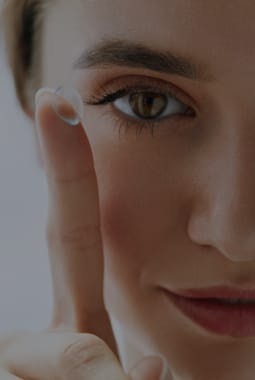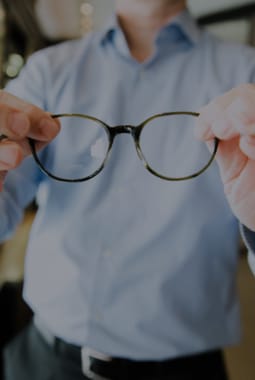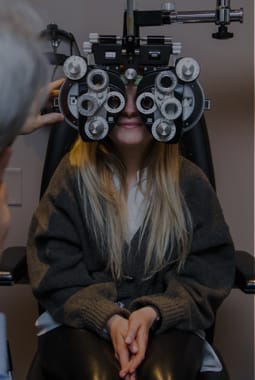Detecting & Diagnosing Dry Eye Disease
You probably do not think about how your tears contribute to your overall eye health. But, they are critical to clear vision and comfortable eyes. If you do not produce enough tears or your tears are out of balance, you may have dry eye disease.
While common and treatable, dry eye disease is uncomfortable. Fortunately, Dr. Abrams has years of experience working with patients suffering from dry eye disease. We have invested in the latest technology and can detect your dry eyes during a comprehensive eye exam.
Everyone’s eyes are unique, and your dry eye treatment plan will be tailored to your individual circumstances. Book an appointment to find relief from dry eyes today.

Dry Eye Discomfort
Several symptoms may indicate dry eye disease. Some of these include:
- Gritty sensation
- Burning sensation
- Excessive tearing
- Redness
- Foreign body sensation
- Stringy discharge
- Eyelids that stick together upon waking
- Sensitivity to smoke or wind
- Light sensitivity
- Discomfort while wearing contact lenses
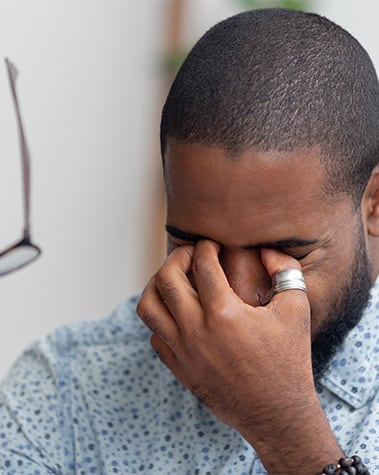
What Causes Dry Eyes?
To treat your dry eye disease, your optometrist will need to understand the root cause. Several causes of dry eyes include:
- The normal aging process
- Hormonal changes
- Environmental conditions like high altitude or dry climate
- Environmental irritants like smoke
- Contact lens use
- Certain medications
- Autoimmune diseases
- Meibomian gland dysfunction
There are 2 main subtypes of dry eye disease: aqueous deficiency and evaporative. It is also possible to have a combination of the two.
Aqueous Deficiency
When the eyes simply do not produce enough tears, you may have aqueous deficiency dry eye disease. This type of dry eye disease accounts for only 10% of dry eye cases.
Evaporative
Evaporative dry eye disease is the most common form. It occurs because your tears are of poor quality.
A balance between the layers of your tear film is necessary to maintain clear, comfortable vision. The tear film is made of 3 layers:
- Oil prevents evaporation.
- Water hydrates the eyes and washes away irritants.
- Mucus helps the tears spread evenly over the eyes.
Evaporative dry eye disease may occur when there’s a blockage in the oil glands that produce the outer oily layer of your tear film, resulting in a tear imbalance and rapid evaporation of the water layer.
Managing the Meibomian Glands
The oil glands along the edge of the eyelids are called meibomian glands. They produce the oil layer of your tear film.
If there are blockages or abnormalities in the meibomian glands, a deficiency in the oil layer may result, causing dry eye disease.
Blepharitis, the inflammation of the eyelid area, is both a cause and a symptom of meibomian gland dysfunction. Inflamed eyelids can block the meibomian glands, and if the meibomian glands do not produce enough oil, the eyelids can become inflamed.
How Do We Diagnose Dry Eye Disease?
Dr. Abrams has invested in the latest technology to diagnose dry eye disease.
Meibography
We image the meibomian glands using meibography. It is a non-invasive, in-office procedure that allows us to see the meibomian glands and surrounding area in detail.
Not only does it help us see and monitor what is happening with your glands, but it also helps us show you as well.
Osmolarity Testing
Osmolarity testing determines the concentration of your tears. People with dry eye disease often complain of a gritty or burning sensation—the relative increase in salt concentration as aqueous fluid declines may be the cause.
Start Your Journey to Dry Eye Relief Today
If dry eye disease is left untreated, it can be harmful to your ocular surface. Fortunately, Dr. Abrams offers several state-of-the-art technologies to treat dry eyes.
Please book an appointment to find dry eye relief today.
Our Location
Where to Find Us?
We are located on the northwest corner of Hwy 7 and Pine Valley Dr.
Where to Park?
There is ample free parking available immediately directly in front of our ground floor entrance
Our Address
- 4610 Hwy 7, Suite 110
- Woodbridge, ON L4L 4Y7
Contact Information
- Phone: 905.850.2400
- Fax: 905.850.9012
- Email: info@drbrianabrams.com
Hours of Operations
- Monday: 9:00 AM – 7:00 PM
- Tuesday: 9:00 AM – 5:00 PM
- Wednesday: 9:00 AM – 5:00 PM
- Thursday: 9:00 AM – 7:00 PM
- Friday: 9:00 AM – 5:00 PM
- Saturday: 9:00 AM – 2:00 PM
- Sunday: Closed
Why Choose Us
Trusted in the Community
Dr. Brian Abrams Optometrist has been a trusted provider of family and specialized care in Woodbridge, Vaughan, for more than 2 decades. Our team has been a trusted service provider in the Woodbridge community since 1994.
Patient-Centric Approach
Your experience is our priority. From your first consultation following every subsequent visit, every member of our team is here to answer your questions and make you feel comfortable.
The Most Advanced Equipment
Our office is equipped with the best equipment and the latest technology, enabling our teams to deliver the most comprehensive and effective care, from diagnostics and exams to treatments.
Full Range of Services
We provide our customers with a wide range of high-quality and professional eye care services for every member of the family, so you can get all the care you need from one convenient location and one trusted provider.
Fast Responses
Our office is open 6 days a week and is easy to access for convenient and prompt services. We urgently respond to your requests so you can address all your eye care and optometry needs efficiently. When emergency care is required, we accommodate same-day appointments based on severity.
Expert Teams
Dr. Brian Abrams is a graduate of one of the world’s leading eye care institutions and an Ontario Association of Optometrists member. While our team has many years of education and experience, we continually participate in courses to expand our knowledge and services.

Our Brands
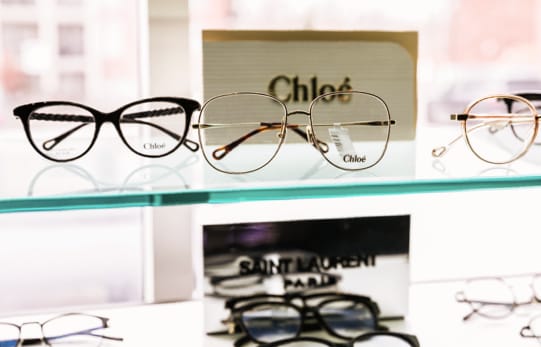







Our Google Reviews
Our Blog
Tips for Healthier Eyes for Those with Diabetes
Diseases and DisordersIf you have diabetes, you know that it’s important to take caution to protect your eye health. Diabetes is a condition where fluctuations in blood sugar can affect different parts of the body and, as a result, different areas of your life. Your vision is an important gift and it’s important to protect. Unfortunately, when […]
Read More… from Tips for Healthier Eyes for Those with Diabetes
How to Recover from Digital Eye Strain
Eye CareTipsDigital eye strain is a prevalent condition that virtually everyone in Canada who uses a phone, computer, tablet, or even TV experiences to some degree or another. Overuse and strain on your eyes can be debilitating, causing symptoms like severe eye pain, migraines, light sensitivity, and discomfort, affecting one or both eyes. The best way […]
How Do Emergency Eye Clinics Handle Chemical Exposures?
Eye CareYou’re exposed to chemical solutions more often than you realize just by being at home, whether you’re cooking, cleaning, or even participating in your favourite hobby. This risk only increases at work for those who have higher-risk occupations or work in higher-risk settings like pharmaceuticals, medical practices, factories and manufacturing plants, and more. Your eyes […]
Read More… from How Do Emergency Eye Clinics Handle Chemical Exposures?
Tips for Healthier Eyes for Those with Diabetes
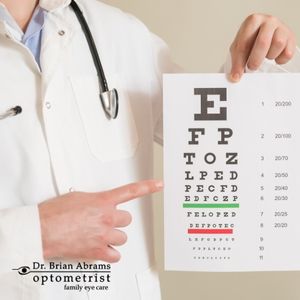
If you have diabetes, you know that it’s important to take caution to protect your eye health. Diabetes is a condition where fluctuations in blood sugar can affect different parts of the body and, as a result, different areas of your life. Your vision is an important gift and it’s important to protect. Unfortunately, when […]
Read More… from Tips for Healthier Eyes for Those with Diabetes
How to Recover from Digital Eye Strain
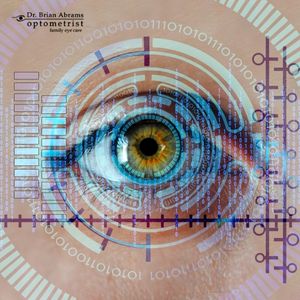
Digital eye strain is a prevalent condition that virtually everyone in Canada who uses a phone, computer, tablet, or even TV experiences to some degree or another. Overuse and strain on your eyes can be debilitating, causing symptoms like severe eye pain, migraines, light sensitivity, and discomfort, affecting one or both eyes. The best way […]
How Do Emergency Eye Clinics Handle Chemical Exposures?
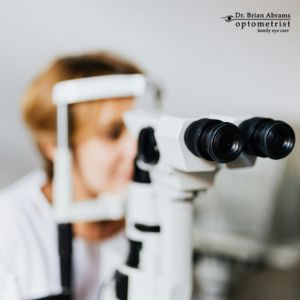
You’re exposed to chemical solutions more often than you realize just by being at home, whether you’re cooking, cleaning, or even participating in your favourite hobby. This risk only increases at work for those who have higher-risk occupations or work in higher-risk settings like pharmaceuticals, medical practices, factories and manufacturing plants, and more. Your eyes […]
Read More… from How Do Emergency Eye Clinics Handle Chemical Exposures?




